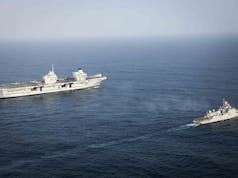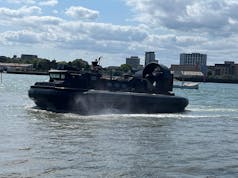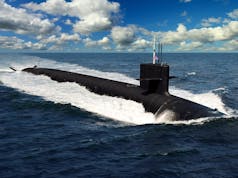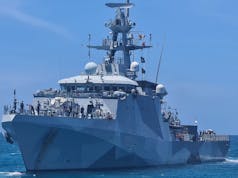Leonardo has signed a twenty-year framework agreement with the Danish Defence Acquisition and Logistics Organisation.
The agreement provides for logistics support and the possible future upgrade of the seventeen 76/62 Super Rapid Gun Mounts which are in-service on the Danish Navy’s Iver Huitfeldt Class Frigates, Thetis Class Inspection Ships and Knud Rasmussen Class Inspection Ships.
The agreement is worth up to a total value of 70 million Euros and can be extended in line with the needs of DALO and future budgets.
“The 76/62 Super Rapid (SR) Gun Mount is a lightweight, rapid-fire naval gun which delivers performance and flexibility in all air defence and anti-surface roles, particularly in an anti-missile role. The 76/62 SR is suitable for installation on ships of any type and class, including small naval units. The scope of the agreement between Leonardo and DALO ranges from basic support supplies, such as spare parts, tools and technical logistics services, up to gun upgrades and the provision of brand new 76/62 SR guns in their most up-to-date configurations.
The first purchase orders are expected to be for materials necessary to maintain operational guns and for a plan to replace all original consoles with a new digital version. The deal highlights Leonardo’s ability to ensure customers to perform their mission, by offering logistics solutions which maximise the value and utility of its products over time. It consolidates the Company’s partnership with DALO, one of the most important customers in the naval defence systems sector, a relationship which formed in the 1980s and is projected to last long into the future.”














Great value for money those Iver Huitfeldt ships!
Agreed. The Danes caused many to pay attention to what can be achieved on a budget for low build and operational costs. I wonder if the Danes might be a T31 customer sometime in the 2020’s to start replacing their Thetis class, which are nearly 30 years old at this point. As I understand it they no longer have the dockyards for their own builds.
Why would they buy Type 31 when they own the base design?
Per my last sentence, because I understand they no longer have the ability to assemble blocks in their own dockyards as they did for IH. the Odense shipyard closed. I suppose they could again use Estonian and Lithuanian yards to build blocks and then have a foreign location assemble the ships too but do they gain anything at that point, since OMT benefits from a T31 build anyway.
This is true. As for the Thetis replacement: I am not sure the T31 will be a good match. The Thetis class are dedicated for arctic operation and have moderate ice breaking capability (Up to 1 m I beleive)
Good point, T31 won’t be a good match if they want to retain that capability.
Babcock bought the IH design exclusively.
The original design is right now beening modified, in the detailed design stage of the Type 31 Frigate.
They might take inspiration from the T31 decision, but doubt they would buy ships from UK. If they proceed with such a concept i suspect they would return to the Baltic State (cant remember whether Estonia, Latvia or Lithuania) shipyard which build the Iver Huitfeldts in the first place. The Danish Navy and procurement organisation i suspect would manage the programme again and Danish suppliers would integrate different elements of the ships. At most they might contract consultancy services from Babcock but not much else.
Danes closed the Odense shipyard where IH blocks were assembled so no longer an option. But PeterDK makes a good point regarding the potential ice breaking spec requirement that would be a deal breaker if the Danes want to replicate the capability of the Thetis ships.
Yes, impressive ships.
I wonder whether transferring across the concept of a modular weapons fit, either literally Stanflex or something inspired by it but dedicated to Sea Ceptor hence possibly simpler/cheaper, was considered when deriving the T31 design from this class.
Given the relative simplicity of Sea Ceptor soft launch I wonder how complicated/costly it would have been to make Sea Ceptor silos modular so that they could be lifted out of any ships in reasonably extended periods of maintenance for use on active vessels. If T26 and T31 had been designed to share the same modules then, with at least one of 8 T26 likely to be in reasonably extended maintenance at any given time, that would have given 2 x 24 silo modules that could have been used for active T31s at no extra cost apart from the premium for modularisation (the T26 programme is funding 48 Sea Ceptor launchers per T26). Additionally it would have automatically given T31 a 24 canister silo as opposed to the currently planned 12. It would also open up the possibility of expanding the use of modular Sea Ceptor silos to other future vessel classes.
Yep, the area where T31 has its 12 Sea Ceptor silos is the same area where the Danes have a Stanflex module (not dissimilar to a MEKO module) for 32 MK41 VLS silos for SM-2 missiles, plus an additional 24 launchers for ESSM. I wonder to what extent the addition of a further two boat bays on the T31 has constrained space for a full width Stanflex type container.
It has been reported in the news that Indonesia are looking to purchase two Iver Huitfeldt frigates. How would it work in a few years time when T31s are available to export, could they be competing against the Iver Huitfeldts or has an agreement been made I wonder? There are quite a few countries who would look at the T31 with its mission flexibility and lowish cost, that would fit their requirements.
If we’ve followed the recommendation from the Parker report then we should have ensured we have an exportable product so no one owns the design except the UK. So OMT should no longer own the design if we’ve done things right. At the very least you’d hope the UK has a veto on OMT offering the design to others. However I doubt that’s the case and all we have done is given OMT a huge leg up due to the RN selecting their design.
I suspect Babcock has full rights over its own design and is free to offer it around the world. I suspect however that neither side is allowed to constrain or stop the other from offering its own design in competition with the other. Having said that, I suspect they would agree not to compete depending on the complexity of the requirement or whether Denmark or the UK stood the better ‘political’ chance of winning the deal. I also suspect Thales might have a say in any decisions given the degree of systems integration on the T31 under their responsibility
Doesn’t Damen have a large shipyard in Indonesia? Even if the IH design wins the contract the ships would not be built in the uk
Damen owns a shipyard in the Philippines, not Indonesia.
The naval yard in Indonesia is government owned since it’s inception. First by the Dutch, then the Japanese and finally the Indonesian government. Most major naval ships are/will be built there.